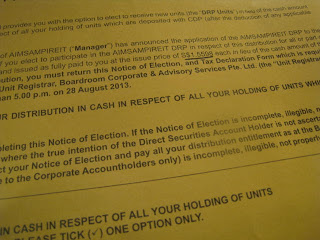Despite a much weaker JPY, Saizen REIT has delivered a respectable income distribution in S$ terms, a DPU of 0.63c to be precise.
Saizen REIT's DPU in JPY terms has been improving steadily in recent years. In the last half a year, DPU in JPY terms has shown an improvement too but a much weaker JPY means that DPU took a hit in S$ terms.
Income in JPY terms climbed mainly due to new acquisitions. Of course, a buy back and cancellation of shares also helped.
As of 30 June 2013:
NAV/unit: 25c
Gearing: 38%
Interest cover ratio: 6.0x
To reduce the impact of a weakening JPY on income distributions in S$ terms, Saizen REIT's management entered into hedging transactions.
The rate for the 6 months period which ended on 30 June 2013 was JPY75.12 = S$1.00. The rate for the 6 months period ending 31 December 2013 is JPY 81.15 = S$1.00. It is going to be some 14% costlier to buy S$, it seems. So, if I read this correctly, we should see downward pressure on the next income distribution in S$ terms, everything else remaining equal.
Saizen REIT has refinanced and in so doing brought down its average interest rate as well as its rate of amortisation. Yes, regular readers will remember that Saizen REIT's loans are amortising in nature. It will also not see any loan maturing until four and a half years later in February 2018.
So, is reducing the rate of amortisation a good thing? Well, it will mean that the REIT will have more income from operation available for distribution. However, it is unlikely to mean a higher income distribution in JPY terms because the REIT is currently using its cash resources to offset amortisation in order to free up more income from operations for distribution to unit holders anyway. It will, however, mean that there is less strain on the REIT's current cash resources.
The management is also proposing to do a 5 to 1 unit consolidation. This is a bit of a déjà vu. I remember the time when AIMS AMP Capital Industrial REIT did a 5 to 1 unit consolidation too. Fundamentally, it really doesn't change anything.
Qualitatively, investing in Saizen REIT now is to invest in freehold Japanese residential properties at a discount to their valuations. If we believe that the Japanese economy will enjoy a revival as Abenomics gain traction, then, Saizen REIT could be a good proxy as the country frees itself from deflationary forces.

The REIT's numbers are good but the persistent weakness of the JPY as the BOJ stays the course with its own brand of QE is going to lower income distribution in S$ terms in the foreseeable future. A conservative forecast of 1.1c in annual DPU would mean a distribution yield of 5.8% assuming a unit price of 19c. Compared to J-REITs with residential properties in Japan, this is relatively high and although it is not particularly cheap at current prices, Saizen REIT is not overpriced.
See FY2013 presentation:
here.
Related post:
Saizen REIT: DPU of 0.66c.







































